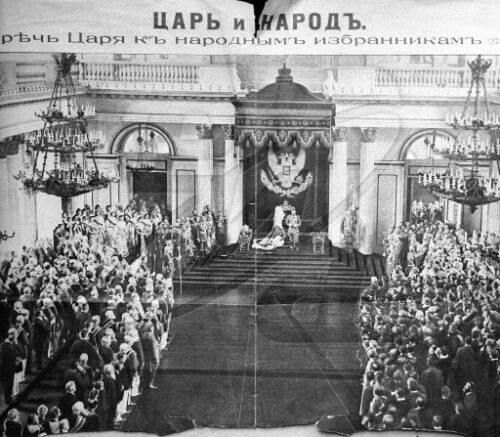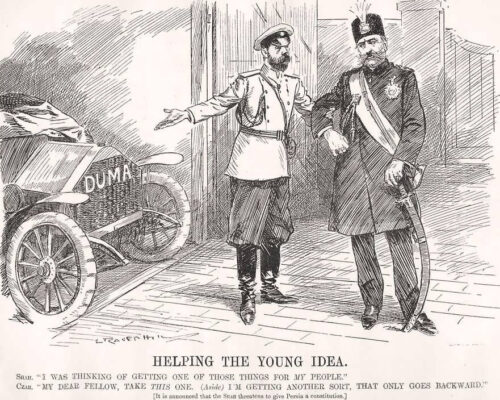
Tsarism was challenged and threatened but not reformed by the 1905 Revolution. Nicholas II’s approval of the October Manifesto marked a surrender to the advice of Witte, Nicholaevich and others, rather than a genuine move towards reform. Deep in his heart, the tsar still nurtured outmoded political values: autocracy, orthodoxy and divine right monarchy. Strangely, he considered the October Manifesto an expression of his autocratic power: only the tsar could give the people a Duma, so he could just as easily change his mind. In the wake of October 1905, Nicholas organised a tsarist reaction against the reformism that threatened his autocracy. Men like Witte were shelved or kept at arm’s length, as Nicholas turned instead to conservatives and reactionaries. By 1907 the tsarist government had suppressed radical opposition, rigged the Duma and restored autocratic power. But Russia’s revolution was delayed, not defeated; the tsar’s duplicity had only bought time for his doomed regime.
But with the revolutionary coalition now broken, the tsarist government felt confident enough to suppress radicalism. In November the tsar’s police arrested 260 members of the St Petersburg Soviet, including Trotsky. Union leaders and strike organisers were also targeted. Eight newspapers in the capital were forcibly closed and several writers and publishers were arrested.
In early December, an alliance of Bolsheviks, Mensheviks and Socialist-Revolutionaries launched an ambitious uprising in Moscow, where they stockpiled weapons, blockaded streets, shelled buildings and murdered government officials. The December uprising was brutally crushed by the military, which bombarded their sections with rifle fire and heavy artillery, killing more than 1,000 people.
By mid-April, the composition of the 487 Duma seats had been finalised. More than one-third of the Duma (179 seats) was won by the liberal Constitutional Democrats. Left-wing groups like the Trudoviks (a labour-based party), the SRs and several pro-socialist independents, occupied more than 150 seats.
“The tsarist authorities could not settle on a clear-cut policy toward the Duma. They allowed the elections to be held, they arranged a solemn ceremony to mark the opening of the legislature that enhanced its aura of legitimacy, and they made other gestures that suggested a willingness to cooperate with the new institution. On the other hand, the authorities had limited the Duma’s prerogatives before it ever met, had appointed a prime minister and other ministers hostile to any form of representative government, and in numerous other ways had indicated a deep distrust of the legislators, who in turn gave little evidence of favouring a conciliatory strategy… The relationship quickly turned acrimonious, condemning the first experiment in popular government to an ignominious failure.”
Abraham Ascher
Nicholas retained full sovereignty by divine right; the notion that government power was derived from the people was disregarded. The tsar alone possessed constitutional and legislative power. Only the tsar could alter or modify the constitution; the tsar also retained the authority to initiate, amend or repeal legislative, with or without the endorsement of the Duma. Government ministers were appointed by the tsar alone; they were not answerable or accountable to the Duma.
This regressive constitution betrayed the promises made the previous year. The October Manifesto had declared an “unshakeable rule that no law can come into force without approval by the State Duma and representatives of the people”; the Fundamental Laws reneged on this, decreeing that all laws were subject to the will and the approval of the tsar. Privately, Nicholas made no secret of the fact that he thought the October Manifesto was a mistake, the product of poor advice from Witte.

The Duma met for the first time on April 27th 1906. With its ranks dominated by reformists and its legislative power betrayed by the tsar’s Fundamental Laws, the first Duma soon developed a hostile relationship with the tsar’s government.
Nicholas showed his contempt for the Duma from the outset. He sent his new chief minister Ivan Goremykin, a lacklustre bureaucrat loyal to the autocracy, to submit the tsar’s first item of business: the construction of a new laundry and greenhouse at a university in Estonia. But the indignant Duma ignored this and chose to debate issues of land reform, military funding and constitutional change. It urged Nicholas to rescind or amend the Fundamental Laws, requests he flatly denied.
The tsar’s new chief minister, Pyotr Stolypin, dissolved the Duma after ten weeks. As they prepared to depart, 197 Duma deputies signed a petition urging others to defy the tsar and continue meeting in Vyborg, Finland. Many of the signatories to this petition were later persecuted, imprisoned or exiled.
The second Duma was marked not just by demands for change and criticisms of the government, but also anti-tsarist speeches and accusations. The Duma’s 18 Bolshevik deputies did little other than deliver tirades against the tsar, his ministers and other conservative elements; some of these were purposely written by Lenin himself. The government tolerated this until June when Stolypin again dissolved the Duma and ordered the arrest of its Menshevik and Bolshevik deputies for sabotaging the legislature.

It became clear to the tsar and his ministers that if the Duma was to continue, its composition would have to be altered. Stolypin set about developing a new electoral law that would keep socialists and radicals out of the Duma. If “sane men” are to prevail in the Duma, he later said, then “we don’t want professors but men with roots in the country, the local gentry and so forth”.
“The Pyotr Stolypin who emerges from an examination of extant documents is quite different from the cold-hearted ruthless ogre often encountered in scholarly works… It is true that he did not shrink from the use of force to stamp out unrest and that at times he resorted to force more extensively than could possibly be justified, but he was not bloodthirsty. In fact, he lamented the use of force and preferred non-violent means to curb the opposition. Nor was he a man without principles, prepared to advance his own career at any cost.”
Abraham Ascher, historian
The government would help aspiring kulaks with banking facilities, loans and assistance for purchasing machinery or livestock. A “land bank” was also established to ensure that land was allocated fairly and efficiently, rather than by the commune. Small plots of land would be consolidated and given to successful peasants, rather than to individuals or families barely capable of using them. Peasants willing to relocate to Siberia were given government assistance and 40 acres of land.
Stolypin’s reforms were incentives rather than directives: most were not forced on the population. Nevertheless, they encountered significant resistance. Stolypin convinced the reluctant tsar that creating a new affluent peasant class and breaking the hold of peasant communes would only strengthen loyalty and affection for the throne. Representatives of the communes naturally objected since the reforms threatened both their control of land and the social order in villages. There was also opposition from the land-owning nobility, whose own interests, rentals and profits were threatened by changes to the peasantry.

1. In late 1905 the tsar deployed police and troops to arrest or disperse radical political groups, like the Soviets.
2. In April 1906 the tsar issued the Fundamental Laws, a constitution that reasserted his autocratic power.
3. A Duma was elected as promised but its reformist majority was hostile to the government, leading to its dissolution.
4. In 1907 chief minister Stolypin rigged electoral laws to ensure the third Duma would be dominated by conservatives.
5. Stolypin also initiated economic and land reforms to facilitate the creation of a new peasant class, who would be economically and financially successful but would provide the tsar with a conservative supporter base.
© Alpha History 2018. Content on this page may not be republished or distributed without permission. For more information please refer to our Terms of Use.
This page was written by Jennifer Llewellyn, John Rae and Steve Thompson. To reference this page, use the following citation:
J. Llewellyn et al, “The tsarist reaction to 1905” at Alpha History, https://alphahistory.com/russianrevolution/tsarist-reaction/, 2018, accessed [date of last access].
